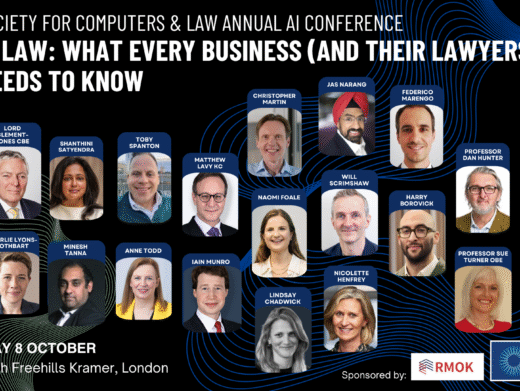From Peter Sommer, Visiting Professor at the London School of Economics, a Visiting Reader at the Open University and leading expert witness: www.pmsommer.com
Three predictions, all related to issues around digital evidence.
1. Few outsourcing and cloud services contracts have explicit terms dealing with the supply of digital evidence and fewer still with assisting clients to meet the obligations of e-disclosure. Civil Practice Direction 31B translates the requirements of standard disclosure to Electronically Stored Information; a key test is whether a document is ‘within the parties’ control’. The courts are unlikely to be impressed when a litigant says that although he can access the document for regular business purposes the document itself is not in his control because it is on a third party’s computer, even in another jurisdiction. In the absence of contractual provision, the outsourcer/cloud services entity will be able to charge what they like. We will probably get several unfortunate examples in 2012.
2. On the criminal side, law enforcement agencies have been quietly and persistently complaining that the Regulation of Investigatory Powers Act 2000, with its difficult-to-interpret definitions of content and communications data, needs radical overhaul. It no longer reflects the range of services on the Internet or the technical methods of investigation the police would like to use. The debate will be a difficult one as, along with their desire for reform, law enforcement will also be nervous of discussing too much about their techniques for fear of alerting their targets. But without such public discussion, parliament and the public will be unable to decide the balance between police powers and controls to prevent abuse.
3. Also on the criminal side, the reduction by the Legal Services Commission and the Ministry of Justice to hourly rates for experts in computer evidence will make it more difficult for criminal defence lawyers to obtain good quality advice for routine cases. The new scheme maintains the bizarre exaltation of medical evidence over all others with little reference to either the market place or the skills involved. Digital evidence experts will cherry pick and/or migrate to privately funded criminal work and the ever-increasing demands for support in civil litigation.
From Mike Taylor of i-Lit Limited (www.i-lit.co.uk), who has advised law firms and their clients on e-disclosure best practice and strategy since 2006
The first Software as a Service e-disclosure data processing solutions will appear in the UK market place. This cost effective alternative will open up e-disclosure to lower value claims as well as increase the level of disputes between lawyers about e-disclosure itself.
The topic of Computer Assisted Review will continue to be hyped by providers and commentators alike. Uptake of the service will remain low with it being used as a prioritisation tool rather than a pure review tool.
Even more small e-disclosure service providers will spring into life as it becomes easier and easier to buy and use ‘off the shelf’ e-disclosure software products (with varying levels of success).
Whilst cost will continue to play a dominant role in decisions made by law firms on what e-disclosure service providers and tools to use, poor experiences on cost overrun and quality of service will start to adversely affect some e-disclosure businesses.
Law firms that do not yet have an effective e-disclosure strategy will really start to feel the pressure from well prepared opponents.
Despite the UK no longer having a ‘discovery’ process many well-known commentators will continue to insist on referring to UK e-disclosure as e-discovery, fuelling the perception that what we do in the UK is identical to that which is done in the US. It is not.
Whether to outsource, insource, offshore, inshore or nearshore review services will continue to be at the forefront of the mind of litigation departments, with more and more opting for insourced services as offshoring starts to look like less good value for money.
Disclosure of social media data in most commercial disputes will grow but not to any great level, it seems to me to be becoming apparent that any social media, regardless of how it markets itself, is 99% social with almost no actual business being done in this forum and so it is pretty easy to argue that it is disproportionate to examine this data source.
From Andrew Haslam of Allvision Computing, independent litigation support consultant who provides specialist legal IT advice and e-disclosure strategy to the UK’s top law firms
Despite what the Mayan calendar says the world will not come to an end, though it might seem so for some people. In particular the following will be affected.
Law Firms – Never mind ‘Tesco law’, the advent of Co-op Legal Services will dramatically change the legal landscape, though it will be more of a gradual ‘landslip’ as the ground erodes from under your feet, than a ‘landslide’ or even ‘avalanche’ effect. The firm has stated ambitions of putting one or more lawyers into every store it has throughout the UK, so some 8,000 plus lawyers to start with. It has successfully carried out lateral hires in its key areas, and is looking to change the way in which it organically grows by recruiting straight from school/university and training in-house. It has tasked its own software development resource with providing it with applications (workflow, document management, disclosure/litigation support) that are built to their standards and not to the niche that is the legal sector. Finally, it has a business model that does not have to sustain a partnership, lock-step and annual six figure PPP, with a command structure that can just get on with it. At a time when lawyers are regularly judged to be as trustworthy as estate agents, the power of a high street brand name should not be underestimated.
Litigation Support Vendors – There will be ‘blood in the water’ as the increasing volume of information to be processed exacerbates the pressure on the current per GB pricing model. Constant demands from prospective clients for, on the one hand, a mechanism for dealing with the very small trickle of electronic information at the start of most cases yet, on the other, the need to cope with increasing volumes of data for the cases that do come to fruition. The need for transparent, easy to understand pricing frameworks will drive suppliers to look for more innovative and reactive ways of pricing. In turn, the drive to differentiate themselves from the competition will lead to a further spate of consolidations, mergers and acquisitions. <pq>There will be functionality creep as software vendors add capabilities to extend their offerings into newer parts of the EDRM model. Early Data Assessment (EDA) tools will bolt on litigation support functions, as fast as the Litigation Support suppliers extend their EDA capability. The market will homogenise and what will be left to distinguish between the products will be the added value of the services. When you are going to have open heart surgery, you don’t ask the consultant what type of scalpel they are going to use. Some vendors will be the Christian Barnards, others the Harold Shipmans.</pq>
Review/Coding ‘factories’ – Be it teams of in-house resources, or inshore/offshore personnel, the rise of the technology known as ‘predictive coding’ will reduce the reliance upon the most expensive part of the electronic disclosure process, that is the review by the Mark 1 human eyeball. There will still be a need for qualified human beings to interact with, and guide, the review tools, but pressure from clients and the courts will bring these tools firmly into the mainstream. There will be another UK case in which a judge will make comments about the availability of such technology and indicate that it should be used, but there will not be any pronouncements on which electronic ‘spanner’ or ‘screwdriver’ you should buy.
Data Collection Teams – The rise of social media in general, and Yammer in particular, will create even more headaches for the people tasked with identifying and collecting the data at the start of any process. People will be forced to hand over logins and passwords to various sites and HR departments will be kept very busy dealing with the fallout.
It will however be an excellent year for forward thinking individuals and companies determined to seize opportunity out of rapidly changing environments.
From Chris Dale of the eDisclosure Information Project
As usual, my predictions for the coming year are delivered more in hope than expectation, given in the hope that they might change things rather than as a realistic estimate that they might do so in the next 12 months. As befits predictions made for a UK magazine, most of these have a UK slant.
The key words for solicitors will be ‘proactive’ and ‘information governance’. Instead of seeing an eDiscovery event (a stage in litigation, the requirement of a regulator, part of an internal investigation) as merely another transactional exercise, they will start making positive recommendations to their clients about how a staged approach to information governance can mitigate the cost and disruption of the next eDiscovery event. There are two prerequisites for this – one is that they educate themselves on the subject first, and the second is that they are willing to give a certain amount of time and resource as an investment to win future work.
Another new word for the solicitor’s lexicon is ‘disintermediation’, the idea that they will (not ‘might’) find themselves left out of that part of the discovery process which has traditionally earned them the fees which subsidise the rest of the process. Outsourcing and technology can do a better job more cheaply, as can the clients themselves in many cases. Those who recognise that the mechanical parts of the eDiscovery process are better done elsewhere will keep the intellectual and purely legal parts of the job for which the clients are willing to pay good fees.
The more alert barristers will realise that one no longer necessarily needs big teams to manage large cases, and will join the service and software providers and the big consulting firms in taking large bites out of the work which solicitors have traditionally seen as their own.
Judges will increasingly self-start on case management, paying more attention to the duty of active management imposed on them by the rules and on the reasons why Part 1 CPR is called ‘The Overriding Objective’. Solicitors will face increasing expectations that they define up-front the scope and cost of the task ahead of them; they will also face costs penalties for failing to do this and for causing opponents to run up costs unnecessarily.
The Serious Fraud Office will bring charges against a UK company or, perhaps, a foreign company with sufficient UK interests to bring them within the scope of the Bribery Act, possibly for activities by third parties somewhere else in the world. In the resulting scramble to make sure that they have ‘adequate procedures’ to prevent bribery, companies will realise that there is common ground between the information governance reforms needed for broader eDiscovery requirements and the Bribery Act ‘adequate procedures’, and that the same investment will cover both.
Non-US eDiscovery investment, particularly in Asia and the EU, will rise as a proportion of the total eDiscovery spend.
The US will stop thinking of itself as ‘two years ahead’ of everybody else as its own eDiscovery rules come under increasing fire from within. With that will come a more realistic approach to data collections from jurisdictions whose discovery rules are more restrictive than those of the US. That will be matched by a growing realisation, in the EU at least, that US eDiscovery cannot simply be ignored, particularly for those seeking the benefit of US trade and US courts. We will not see a result in 2012, but changed attitudes and a better use of technology will be a good start.
From Tracey Stretton, legal consultant at Kroll Ontrack
The rapid explosion of iPhones, Androids, iPads and other smart devices and the rise in social networking as the new way of communicating will make it harder for companies to stay in control of their data and comply with regulatory and litigation requirements. More and more companies will tap into this personal-computing revolution and the business efficiency and agility likely to flow from an influx of new consumer technologies into their businesses. They will do more to address the risks flowing from this new stream of information in social networking policies and security mechanisms.
Companies will have to take seriously the call to get their information houses in order to stay ahead of tech-savvy regulatory enforcement agencies like the SFO implementing the Bribery Act. Given the risk of unlawful or disreputable conduct being exposed in informal, candid and unguarded communications, more companies will review electronic communications as part of the internal audit process to uncover potential wrongdoing such as corrupt practices and negotiate settlements.
Expect to see more postings, tweets and instant messages (both BBM’s and Bloomberg Messages) being called for in litigation disclosure exercises and arguments over relevance, accessibility and proportionality. Lawyers will need to keep a close eye on these technologies and evolving evidentiary and ethical standards as legal practice moves ever further into the electronic world. As the line between personal and business use of devices continues to blur, will privacy become wishful thinking?
Lawyers will do more to get to grips with electronic disclosure under pressure from senior judges, who have made repeated calls in 2011 for lawyer education, and the threat of indemnity costs for those who get it wrong. We can expect to see more data mapping as data is dispersed and scattered across mobile devices and stored in the Cloud and the use of early data assessment technology and expert consultancy to direct lawyers to the key sources of evidence and help scope rational approaches to e-disclosure. New working practices will develop as lawyers turn to intelligent prioritisation technology and predictive coding to reduce the burden of document review. Corporate legal teams will be paying more attention to technology that supports the preservation of evidence and compliance with privacy laws.
Given the importance of contemporaneous electronic evidence in fact finding and the large volumes that need to be grappled with, it has become essential to budget properly for e-disclosure and manage these costs tightly. 1 October 2012 is the target date for the implementation of cost reforms suggested by Lord Justice Jackson including a formal ‘costs management process’. Lawyers will therefore need to focus more on budgeting for costs, in particular on the relationship between the estimated costs and the most likely ultimate recovery or liability at stake, and shape their litigation advice accordingly.
From Charles Holloway, Director at Millnet Financial Limited and lead contributor to the the Smart e-Discovery Blog
Predicting the future is a mug’s game! However, it is fun, so here are my 5 predictions for 2012, in no particular order.
1. Whether you call it inshoring, outshoring, outsourcing, northshoring or just stick with legal process outsourcing or LPO, it is likely that the process will continue to be in the news in 2012. There is so much difference between the rates of pay of a lawyer in Manila, Bangalore and Cape Town on the one hand and London or New York on the other that Managing Partners are bound to sit up and take notice. Add Belfast, Middlesbrough or Tunbridge Wells to the mix and managing partners are likely to find the whole concept irresistible. However, what happens if things go wrong? Examples might include that the quoted cost is not all inclusive of the benefits which have to be paid on top of salary in other jurisdictions, or that the quality is not as expected. English language skills may not be up to the expected standards and fluency may be way off. While accepting the benefits of outsourcing, 2012 may well be the year of a high profile instance of something coming badly unstuck.
2. A PR consultant said to me the other day that Third Party Litigation Funders (TPLF) had not yet had their day. I agree, but I think that TPLF is here to stay. Those I know something about are very busy and others are unable to raise the needed funds. Clearly there is no uniformity in the market. 2012 could be the year that we see a greater acceptance of TPLF in litigation, which does not of course rule out a spectacular collapse of a funder through backing the wrong case(s).
3. Technology Assisted Document Review (TADR) (or predictive coding as the technologists call it) is a hot topic. We have worked on a number of cases recently where TADR has been used. Not all have been entirely successful but the balance is overwhelmingly in favour of using this technology to reduce the costs of litigation. I predict a steady increase in its use.
4. Social media is much in the news. There is much one could say about the whole area but my prediction for 2012 in this area is that there will be the first decided case in this jurisdiction which mirrors the US District Courts’ rulings that access to social media sites and the relevant log-ins and passwords be given to the opposing party as part of the process of disclosure.
5. A long shot this, but 2012 will see the whole issue of data privacy and the transfer of data between the EU and the US take centre stage. Revisions to the EU Data Protection Directive due in 2012 may be the catalyst. What price safe harbor then?




